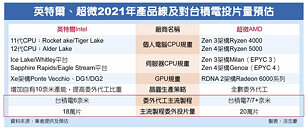Monday, July 27th 2020

TSMC Allocation the Next Battleground for Intel, AMD, and Possibly NVIDIA
With its own 7 nm-class silicon fabrication node nowhere in sight for its processors, at least not until 2022-23, Intel is seeking out third-party semiconductor foundries to support its ambitious discrete GPU and scalar compute processor lineup under the Xe brand. A Taiwanese newspaper article interpreted by Chiakokhua provides a fascinating insight to the the new precious resource in the high-technology industry - allocation.
TSMC is one of these foundries, and will give Intel access to a refined 7 nm-class node, either the N7P or N7+, for some of its Xe scalar compute processors. The company could also seek out nodelets such as the N6. Trouble is, Intel will be locking horns with the likes of AMD for precious foundry allocation. NVIDIA too has secured a certain allocation of TSMC 7 nm for some of its upcoming "Ampere" GPUs. Sources tell China Times that TSMC will commence mass-production of Intel silicon as early as 2021, on either N7P, N7+, or N6. Business from Intel is timely for TSMC as it is losing orders from HiSilicon (Huawei) in wake of the prevailing geopolitical climate.
Sources:
Hexus.net, Chiakokhua (Twitter)
TSMC is one of these foundries, and will give Intel access to a refined 7 nm-class node, either the N7P or N7+, for some of its Xe scalar compute processors. The company could also seek out nodelets such as the N6. Trouble is, Intel will be locking horns with the likes of AMD for precious foundry allocation. NVIDIA too has secured a certain allocation of TSMC 7 nm for some of its upcoming "Ampere" GPUs. Sources tell China Times that TSMC will commence mass-production of Intel silicon as early as 2021, on either N7P, N7+, or N6. Business from Intel is timely for TSMC as it is losing orders from HiSilicon (Huawei) in wake of the prevailing geopolitical climate.

27 Comments on TSMC Allocation the Next Battleground for Intel, AMD, and Possibly NVIDIA
So wich one would i have? A super dense Intel node that is delayed time and time again or a less dense node where i can actually buy products based on that?
The choice is easy.
Intel's problem is that they have this super cool tech "in the labs" but not on shelves: 7nm CPU's. Xe gaming GPU's, PCIe 4.0 Optane SSD's (that they had to develop using AMD's platform lol) etc.
Why that matters - if 10% of Intel's volume is 10nm, that would mean there are as many Ice Lake CPUs being sold than all of AMDs CPUs combined - desktops and laptops. Keep in mind the laptop space is bigger than desktop.
I do see a lot of Ice Lake CPUs on the thin and light laptops now. They are easy to find if you know what to look for, and are not particularly expensive.